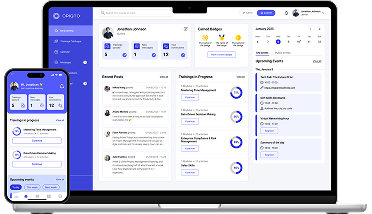Imagine if you were trying to play some modification of "Grand Theft Auto: San Andreas" where you cannot break any traffic laws. Crossed the double solid — bam!, mission failed, start all over again. Bet you would learn all rules by heart by the fifth or seventh attempt without batting an eye and even enjoy the process.
Now compare that with 25 hours of classroom instruction spread over two-and-a-half semester periods — that's how long driver education in California can take before you are even allowed to get behind the wheel with an instructor. Would you feel just as motivated, productive, and entertained in a classroom as when playing a video game? We surely wouldn't.
So why is it that acquiring skills and knowledge is fun and games in one setting but a chore in another? What aspects of video games make learning more compelling, and how can e-learning benefit from them?
That's what gamification tries to answer — a practice of using game elements in non-game settings. In e-learning, gamification translates into an instructional design method incorporating video game mechanics and game design principles into the conventional learning process. But don't worry; you don't have to be a game developer to do that.
You would have to be a game developer, though, to create game-based learning, a.k.a. serious or educational games, where learning happens during the gameplay. It is a different learning approach that requires a different set of competencies and investments. In this article, we focus solely on gamification.
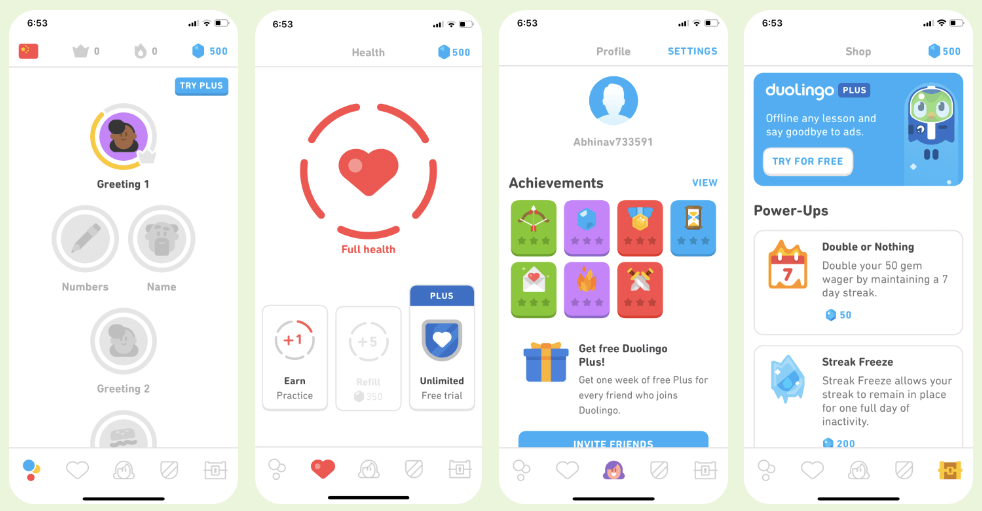
Duolingo is a gamification example — you learn words and rules and do exercises, but it's spiced up with game elements such as difficulty levels, achievements, badges, experience points, etc. Source
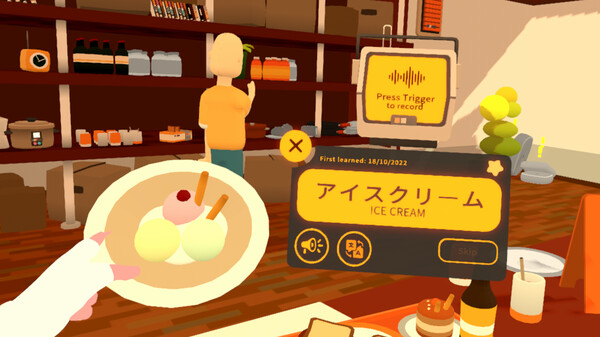
And here is a VR game where you learn new words as you interact with objects and in-game characters while exploring the area and playing mini-games — that's game-based learning. Source
Now that we have outlined the subject let's talk about how it works and how to implement it.
The reasoning behind gamification
The premise of gamification lies in the idea that games have certain properties that keep players hooked even if they need to grind for hours to win, do repetitive tasks, and memorize encyclopedias of game lore. The aspects that help gamers persevere can be used to negate the problem of students dropping out of courses at excessively high rates.
Dozens of legitimate obstacles stand between a learner and their training goal (we've covered them in one of our recent articles.) For example, people stop learning when they don't know what to expect from the course or are unsure if they really need it, when they don't believe in their success and dread the experience, and when the course is poorly designed. Bringing game properties to learning can rectify that to a great extent, helping students to persist in their education quest.
What are these properties, you ask?
Games create a safe space for exploring, competing, and socializing. Its play-pretend nature helps the player to disassociate from their worries and anxieties and not get discouraged by mistakes. The storyline, character stats, game levels, and so on provide clear progression rules, giving the player the feeling of direction and control over the process. Games provide immediate feedback to the player's choices, so they know what exactly they need to improve. Rewards and achievements trigger the feeling of accomplishment. Multiplayer games tickle the competitiveness bone, and big fandoms give a sense of belonging. What's not to love?
Educators have adopted game design principles to optimize the training course structure and set clear objectives. Difficulty levels and a feedback system provide scaffolding. And rewards motivate learners and embody their progress, building up their confidence and self-efficacy. Overall, using game elements can help shift a learner's mindset to associating learning with positive experience.
And if that isn't enough, playing games per se helps enhance cognitive skills:
- Remembering relevant knowledge
- Understanding instructions and finding a correct solution
- Structuring and evaluating new information based on the known criteria and standards
- Creating novel knowledge out of existing elements
It also encourages independent thinking and problem-solving.
How to approach gamification so that it has an actual impact?
Spoiler: dishing out achievement badges for every single task won’t do it.
The world if STEM students got badges and experience points
Effective gamification is mindful gamification, and its results depend on many factors, from learners' personalities to the specifics of the studied topic. However, there are some general steps you can follow to better your chances for success:
1. Identify the problem.
Gamification is not a magic bullet but a toolbox. So to find the right tool, identify the problem you want to solve first. You can discover why learners feel dissatisfied with the course and leave in our article on the dropout phenomenon.
Do your learners need a motivation boost? Do your courses need a better structure? Do you need better scaffolding but can't take more trainers on a team to assist students? Each of these situations requires a different solution.
2. Analyze your learners.
You should understand their objectives and what drives their interest. For example, some people like to compete while others get easily discouraged by losing a competition. Some want to explore the new terrains at their own pace, while others need a nudge of discipline and direction. Some like teamwork, while others thrive when they have sole control over the process.
3. Choose game mechanics that suit your learners and your objective.
As you can guess, one game mechanic can both facilitate and impede learning simply because of people's differences. So after you have defined what contributes to your learners' dropout and found out what types of learners you have, narrow down the game mechanics to those that can alleviate the training issues and accommodate learners' interests.
4. Develop a narrative that incorporates chosen game elements.
The list you prepared in the previous step will probably be messy, and that's okay — the narrative can make everything cohesive. Paint the user's journey and see which mechanics would propel learners through it best. Let's say you want to increase learners' engagement and decide to give them points for completed tasks. They could earn points to have more points than other students, or they could earn experience points to unlock an advanced course. Contextualizing game elements and giving them a purpose makes them more effective.
5. Reiterate.
Do A/B tests, analyze users' feedback, track engagement, see short- and long-term effects, pinpoint another issue, and repeat from step one.
Now, let's dive one level deeper and look at all the game mechanics separately.
How does each game element affect e-learning?
Naturally, there's been a lot of research on the effects of implementing game design principles and separate game mechanics in learning by behavioral, evolutionary, and developmental psychologists and neuroscientists, so let's tap into that.
Most gamification researchers base their works on the Self-Determination Theory, which says people do something when they see an intrinsic value in it and names three basic psychological needs we try to address:
- Competence — the desire to do something well.
- Agency — the desire to feel in charge of our actions, and for our actions to matter.
- Relatedness — the desire to connect with others and belong to a community.
The purpose of gamification of learning is thus to help the learners get intrinsic motivation.
We'll go over game elements from the easiest to most difficult to integrate into a training program and see which learning aspects they are proven, or at least hypothesized, to improve.
Level 1: Rewards.
Rewarding desired behavior is a straightforward way to encourage it. Video games use points and coins to give a player immediate success feedback, which triggers a release of dopamine — a chemical signal responsible for motivation. Repeat the action–reward cycle enough times, and the action itself will trigger dopamine release in anticipation of the reward. In short — appraisals positively affect cognition.
The important part is that the longer the delay between an action and a reward is, the less its perceived value is. However, there's still a way to make the delayed reward a desired goal in itself by using points or coins as an internal currency that can be exchanged for digital and real-life gifts or services. For example, you can give a password manager subscription for personal use to those employees who got enough points during cybersecurity training.
But keep in mind that rewards should correspond with achievement. Giving out hundreds of coins for just showing up will devalue the reward. Ideally, you should create an intrinsic reward loop — where getting the reward is rewarding.
Level 2: Ratings.
After figuring out a point system, the next step is to enable learners to compare their results with their peers via a rating system or a leaderboard.
Ratings cover several aspects at once, the first and the most obvious being the competition between learners. Next, leaderboards provide recognition which acts as a reward. And third, the leaderboard shows the possibility of success and can motivate the learner to reach the top, and goal-setting plays a significant part in motivation.
Note that not everyone is encouraged to try their best when they see themselves at the bottom of the leaderboard, but there are workarounds like showing the user only a couple of positions before and after theirs.
Level 3: Progress indicators.
The system of levels, achievements, and badges celebrates the overall learner's success, recognizes specific milestones, and gives continuous progress feedback. However, unlike a leaderboard, badges and achievements, instead of driving competition, symbolize belonging to a group of learners with the same achievement.
While rewards and ratings can be implemented on top of the existing training, progress indicators often call for course redesign as they involve scaffolding — a gradual removal of the support as the learner gets more familiar with the new knowledge or task. Keeping the optimal difficulty facilitates a smooth learning experience.
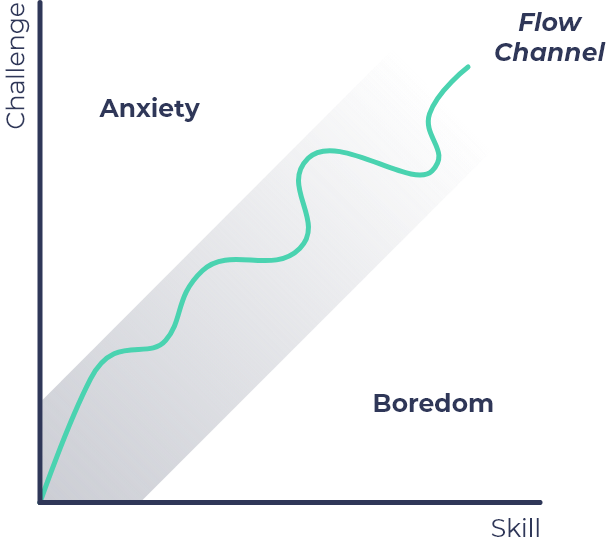
The "Flow" concept by Mihaly Csikszentmihalyi states that the balanced challenge level is crucial for achieving a "flow" state when a person gets completely absorbed into an activity and is the most productive.
In video games, this is usually implemented through level-ups, with each new level being more challenging than the previous one. In e-learning, that means you need to build not one but several courses that unlock after a learner reaches some threshold and identify many mini-goals for different competencies that fit into the main objective of the learning track. The element of unlocking here gives a greater sense of accomplishment.
Level 4: Ecosystem builders.
We are talking about daily tasks, the streak system, overarching narrative and role play, journey maps, and challenges. This is an expert mode of gamification that may require you to rethink the whole training approach — from employee upskilling to building a self-reinforcing learning culture.
Let's start with streaks — actions performed several times in a row, e.g., logging into the platform and completing a task daily without fail. As with any other game mechanic, streaks and daily tasks should be meaningful for learners, driving them closer to their objectives. However, keeping the number going up usually becomes a goal in itself, increasing engagement and facilitating a habit of daily training.
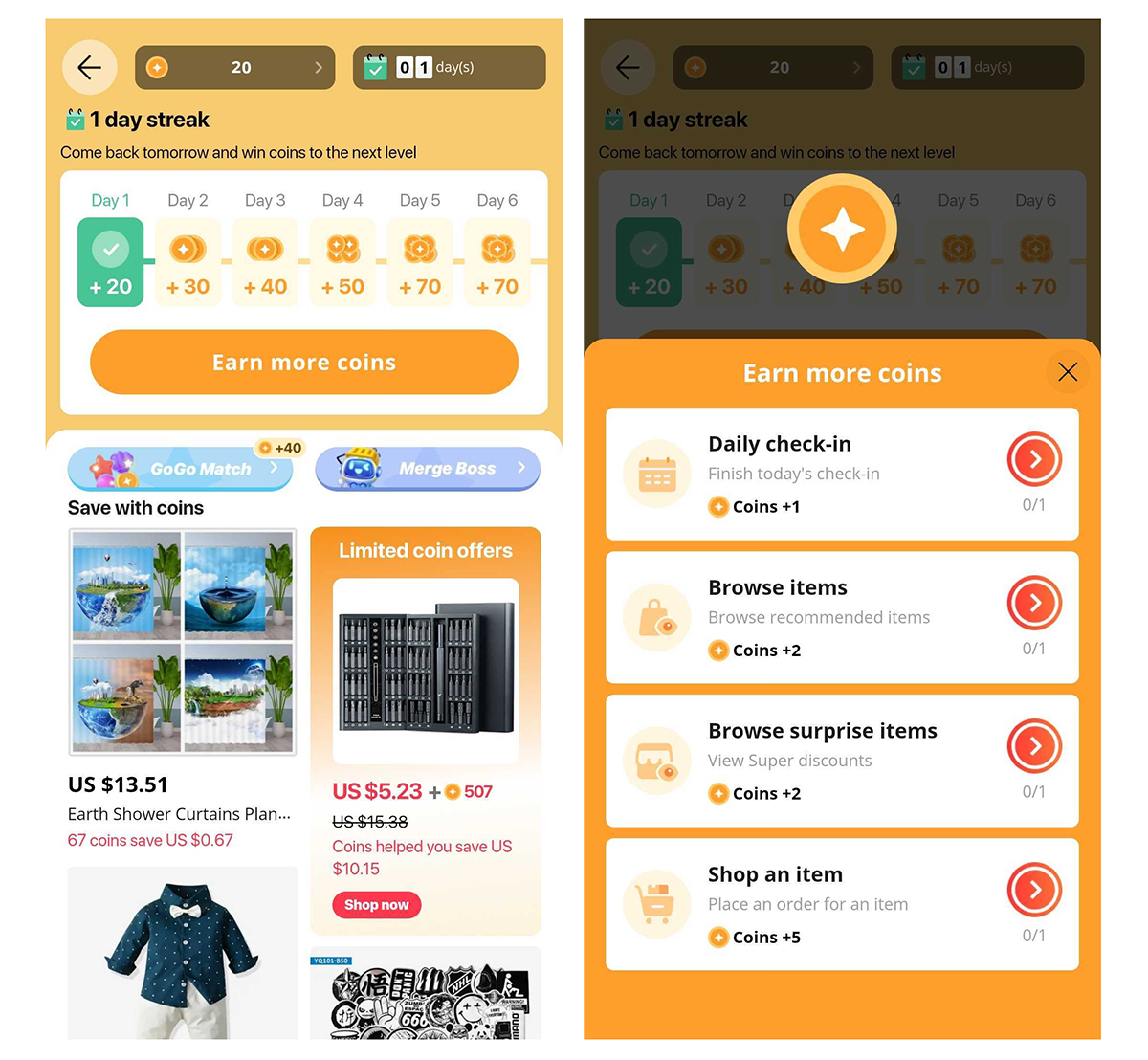
AliExpress successfully uses game mechanics for non-game (e-commerce) purposes: streaks and simple tasks incentivize users to spend more time in the app to earn more coins and exchange them for coupons. Imagine how the same approach can induce learners to train consistently or add some interactivity to their routine work tasks.
Next are challenges, quests, and missions. Whether it's a set up by a training organizer, a user vs. user, a one-on-one, or a team challenge, this is an advanced form of competition: it implies some plot, a need to perform multiple steps, and unlike leaderboards, is voluntary which requires autonomous goal-setting from the learner. This type of competition has intrinsic value for learners and positively impacts their performance and comprehension.
We mentioned that quests and missions usually have some plot, but how about the plot for the whole training system — the narrative? It's more of a game design principle rather than a mechanic, and as such, it affects all other training aspects. Training built around a relatable, fun, or simply interesting story engages learners emotionally, fuelling their interest and investing them in the storyline. Another way to engage the learner in a story is to make them a part of it through role-play. Assign them a character, and give them the ability to express themselves by customizing it, upgrading its stats, etc.
And last but not least are learning journey maps — let learners choose their training trajectories when possible, as it feeds their sense of agency and leads to higher intrinsic motivation and better performance. This is also a way to accommodate different types of learners while keeping the training under one system. Or to run A/B tests without any disruption.
Conclusion
Gamification of e-learning is a tool to improve learners' experience, help them find motivation, and keep them returning to the training, with each game mechanic addressing a specific aspect of user experience — from appraising for correct answers to motivating to create their own training path. However, even the most trivial mechanic should be implemented purposefully to bring noticeable results.
As you master all the basic game mechanics and learn how they impact the training experience, the real fun begins, when you can juggle them in various configurations, i.e., turn sales and marketing departments onboarding into a story about two merchant guilds, set a group challenge for them to get the most achievements and the most consistent streak in a month, and then award the winning group with team building outdoor activities.
P.S.: For those of you who were motivated enough to reach the end of this long read, we have prepared a little treat — a gamification checklist with examples of all game mechanics implementation.
Published on February 28, 2023
